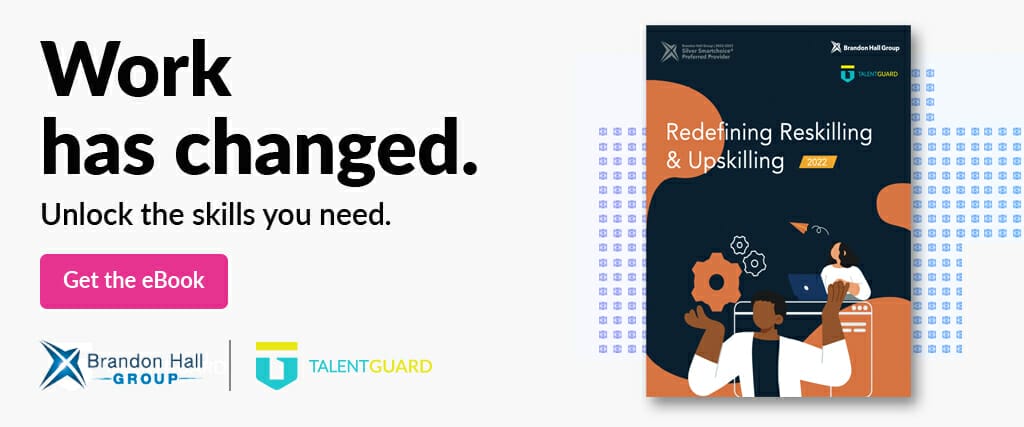Mapping Employee Certifications to Skills

Map Employee Certifications to Skills
Most people today have started to understand the importance of getting certifications and completing courses. However, not everyone realizes the difference between attaining certifications and doing courses for upskilling—and doing it all for maintaining a certain proficiency level.
Every organization has different requirements for employees, and most of them require them to have a certain level of skill, knowledge and certifications to operate. Some organizations require certifications for compliance, while others use them as a benchmark to make sure they hire someone with the right skills.
In any case, it’s imperative to map out how each certification and course determines an employee’s skill and proficiency level.
In this article, we’ll take a closer look at what it means to map employee certifications to skills.
Let’s dive in.
From Skills-First to Certifications-First
Many companies today have moved towards a certification-first culture, rather than a skills-first culture. There are two main reasons for that: Compliance and the fact that being certified implies that the employee has the necessary skills.
Companies have begun using certain certifications as benchmarks for skills and abilities. Some industries are certification-oriented because they may need certain hard skills.
However, not all certifications are accurately mapped to the skills required to operate in a job. Another way to explain it is that while certifications show that you have the necessary knowledge and understanding, it may not indicate whether you’ve actually put the necessarily skills to use.
For example, you may pass your driving test and receive your driver’s license, but that doesn’t necessarily mean you’re ready for every possible situation on the road. Similarly, certain certifications and courses (especially those needed for compliance) can help employees qualify for a job, but it doesn’t pinpoint the extent of that employee’s skills, practical abilities, or experience.
Therefore, it’s crucial to verify the skills an employee should have as a result of a certification. This will help you accurately map out the employee’s proficiency level.
To do so, you need to understand the difference between hard and soft skills.
Understanding the Difference Between Hard Skills and Soft Skills
It’s crucial to differentiate between different forms of skills since each skill has a different upskilling path. You may take a course or complete a certification for a particular skill, but there’s no way of knowing what your actual proficiency level is. It may be that you only gained passive knowledge but didn’t necessarily upskill. It’s absolutely critical to determine this because it shows whether an employee is qualified for a certain job or if they require targeted training.
A more straightforward approach to this problem is to differentiate skills using hard and soft skills.
Hard skills are more technical skills that require a certain level of expertise. These can include things like operating machinery, IT, project management, design, or even marketing skills.
Soft skills can be considered passive skills that are not necessarily tangible but can be observed. Such skills can include communication skills, teamwork, conflict resolution, leadership, and problem-solving skills, among others.
Every employee has a mix of both hard and soft skills – various certifications and courses help employees upskill with different skills. However, it’s essential to understand and map out how a certain certification or course helps improve the proficiency level for any skill.
For example, if an HR person gets an SHRM certification, you need to check what skills have further developed as a result of it. This will help determine what that specific certification means in terms of an employee’s skills and proficiency level. It can also help develop competency-based skills audits for future employees.
Types of Certifications and Courses
There are two main types of certifications and courses:
- Certifications that are developed to fulfill compliance standards so they can act as a benchmark.
- Certifications and courses offered by various institutions and organizations that summarize the holder’s experience with a subject or skill.
The difference between the two is that the second type of certification is often only used for learning and gaining knowledge. On the other hand, the first type determinates whether a certified individual possesses the necessary skills and can carry out any job or activities in their domain.
Both types of certifications and courses play their part in upskilling an employee. The common understanding is that the first type is used to fulfill industry standards and compliance, while the second type is used to build a sizeable knowledge base.
Both kinds of certifications and courses are imperative in building employee skills. However, they should be individually mapped out to determine how much they contribute towards the proficiency level of an employee.
Determining an Employee’s Skill Level
It’s essential to determine every employee’s skill level – it can help you identify high-potential employees.
However, determining employee skill levels can be very different for various skills, and you should always start with known factors.
This includes degree certificates from educational institutes – you can consider what degree it is, what institute it is from, and the grades. Furthermore, you can use skill certificates and online certifications from known institutes. Lastly, you should consider additional certifications and courses an employee has from various organizations and online schools.
A good practice is to assign certain values to each kind of certification and course. You should also assign a value for how much a specific certification or course contributes to building a particular hard or soft skill.
By assigning values to each certification or course’s impact on building an employee’s proficiency level, you can map out its contribution.
Determining your employee’s skill levels can help you create a successful career path for each employee. This will not only help upskill existing employees but will also develop positive employee retention.
How to Map Employee Certifications to Skills
The best way to map employee certifications to skills involves identifying key competencies required for roles, aligning certifications with those skills, and using a dynamic tracking system to update and validate certifications regularly. This approach ensures that employees’ qualifications are effectively utilized and that skill gaps are promptly addressed, fostering continuous development and better role alignment within the organization.
As a result, your company will have a better idea of all the skill gaps any employee has. Furthermore, you’ll have a better idea of what certification or course you can offer the employee to fill that skill gap effectively according to your outlined proficiency levels for a given role.
For example, you’ve determined that any marketing professional in your company will need to get an AMA Certification to understand the intricacies of marketing. To make better use of that understanding, they will need multiple Google and HubSpot certifications. Therefore, you’ve mapped out the path a marketing professional would have to take to improve their proficiency level. Again, this should all match your career architecture to objectively map to the proficiency levels of each role in your company. This helps measure and assess skills objectively, while removing bias along the way.
Map Employee Certifications to Skills to Determine Proficiency Level
While assigning values to certifications and courses can be a different process for each organization, doing so will ensure you have an accurate idea of each employee’s proficiency level. By utilizing your career architecture for each role as a framework will help yield the best results.
Creating and mapping out your process by using assigned values will help you develop an accurate measure of determining employee skill and proficiency levels. Most importantly, it will help you have a realistic idea of any employee’s skills, which can help you in other ways, such as assessing performance by skill level during performance appraisals, helping employees create career paths and development opportunities, determining promotions, and determining who should join a talent pool during succession planning, among other things. When you level up your certification process by mapping certifications to skills and proficiency levels, you will not only meet compliance requirements but you will also gain objective insight into the skills of your workforce and can provide the right resources to help your employees be the best that they can be.
To learn more about how to map employee certifications to skills, check out our Certification Tracking Software page.
For more helpful content, please view our Learning Center.
Hidden Risks of Non-Compliance in Employee Certifications
Employee certifications are an essential part of the modern workplace and vital for compliance. While ensuring your employees are appropriately qualified to do their jobs may seem straightforward, keeping track of the status of their relevant certifications can be a challenge for many employers – and one that can be easily overlooked.
Consequences of Out-of-Date Certifications and Training
Consequences of Out-of-Date Certifications and Training Managing employee certifications and training is a critical responsibility that every company must take seriously. Each year, businesses face the challenge of ensuring that their workforce is up-to-date with the necessary certifications and training required for their roles. When this process is not properly managed, companies can encounter a […]
Reduce Training Compliance Risks in One Easy Step
Reduce Training Compliance Risks in One Easy Step Lapsed certifications and unmet compliance deadlines cost businesses millions of dollars each year in fines and penalties – a large percentage of which could be avoided with the right certification tracking system. Unfortunately, many companies continue to use insufficient processes that rely on manual data entry and an array […]




